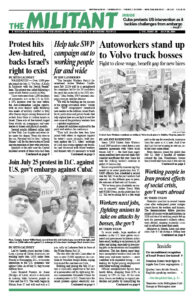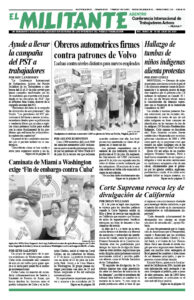Protesters marched in several Iranian cities after widespread power outages caused havoc for workers and farmers. The demonstrations follow previous rounds of country-wide mobilizations in 2018 and since by working people fed up with the government’s military adventures abroad, ongoing economic crisis and its refusal to meet their needs.
Blackouts in Tehran, Karaj and other cities July 4-5 hit during a stifling heat wave. The outages led to the deaths of hospital patients, the closure of factories and cuts to water supplies and air conditioning.
At first, the bourgeois-clerical regime blamed the people for using too much electricity. But following the protests President Hassan Rouhani apologized July 6, fearful that anti-government actions could spread. While the regime has lavished funds on its counterrevolutionary interventions abroad, it has done little over many years to upgrade rotting infrastructure, including the electric grid.
Protests against the outages occurred in Shahr-e Ray near Tehran, Shiraz, Amol and other cities July 5-6. Some demonstrators shouted “Death to Khamenei,” referring to Supreme Leader Ayatollah Ali Khamenei, a reflection of the depth of the discontent felt by working people.
Just weeks before, his regime held presidential elections marked by the lowest voter turnout since the 1979 Iranian Revolution. Ebrahim Raisi, a close ally of Khamenei, won the vote after most of his competitors — especially those who raised any criticism — were disqualified by the regime’s Guardian Council.
In City Council elections, more people spoiled their ballots than actually voted for candidates in three large cities — Karaj, Hamedan and Arak — a further indication of the regime’s waning legitimacy.
Workers face hardships
Mounting hardships from rising prices and shortages have been exacerbated by severe U.S. sanctions, and by the drop in world production and trade during the pandemic. Food prices have risen at least 70% in the past year.
Thousands of workers hired on temporary contracts at some 60 oil and petrochemical installations have been on strike since June 20. They are demanding higher wages and more days off each month.
During the past two decades the state-owned Iranian National Oil Company began hiring workers from contractors on short-term contracts at wages half those it pays to workers directly employed by the company. Over 106,000 workers now come from contractors.
Rouhani dismisses the strike, saying it has nothing to do with the oil ministry and is a matter for the subcontractors to work out. The committee of workers organizing the walkout says they will urge workers hired directly by the company to join the strike if their demands aren’t granted by August.
Other working people are demanding the authorities take action to defend their livelihoods. Farmers in Fars province demonstrated in front of the governor’s office June 27 demanding the government cover the difference between their rising cost of production and the plummeting prices they receive for milk.
The bourgeois-clerical regime is presented in the U.S. capitalist media as the legitimate successor of the 1979 revolution, a powerful popular mobilization that overthrew the U.S.-backed shah of Iran. In fact, the regime consolidated power out of a counterrevolution in the early 1980s to entrench capitalist rule and deal blows to working people. They tried to stifle workers’ councils that were established and set back struggles by farmers for land, gains won for women’s rights and struggles by Kurds and other oppressed nationalities.
Key to advancing the rulers’ counterrevolution at home is seeking to extend their reach throughout the Middle East. The Iranian rulers have deployed militias and Islamic Revolutionary Guard Corps into conflicts in Iraq, Syria and Lebanon. They established missile sites nearer to Israel and extended their political influence at a deadly cost to working people both in Iran and elsewhere. Their intervention has brought them into conflict with peoples across the region.
To force the Iraqi government into paying outstanding debts of some $4 billion to Tehran for providing electricity, the Iranian government cut power supplies to Iraq earlier this month. Tehran provides up to 30% of Iraq’s electrical power, especially to the neighboring largely Shiite-populated southern part of the country.
This intensified the impact of power cuts inflicted regularly on working people by Baghdad. Hundreds of Iraqis took to the streets to protest the most recent cuts in Basra. Temperatures there are averaging 122 F.
“Basra has a lot of money, but its not being used for its people,” Abbas Hassoun told Al Jazeera.
In 2018 and again the next year, power cuts and other shortages triggered widespread protests across southern Iraq. Among the demands raised by hundreds of thousands of workers and youth were that the government provide jobs, that it end rule by sectarian political parties, and that Tehran and Washington halt their interference and plunder of the country’s resources.

